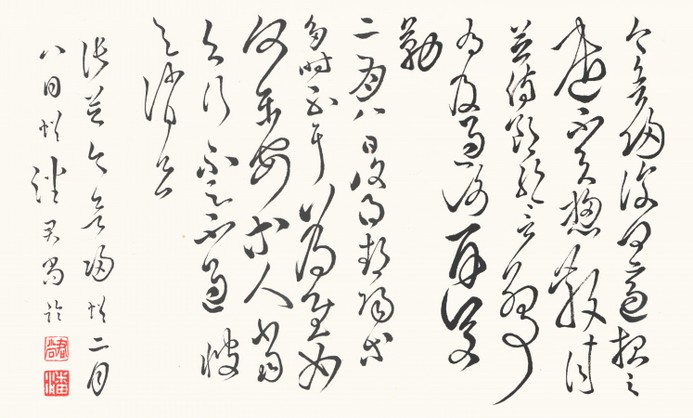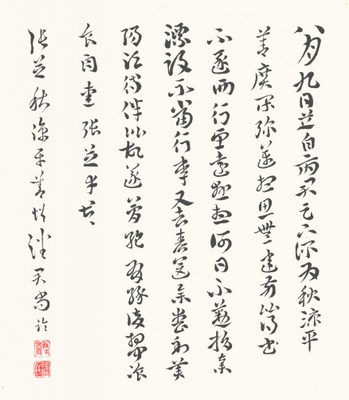Galleries and Translations > Models of Masterpieces > Models of miscellaneous Exemplary Masterpieces by Zhang Zhi 臨張芝諸法帖
Models of miscellaneous Exemplary Masterpieces by Zhang Zhi 臨張芝諸法帖
Historical information
(I)
Zhang Zhi (張芝,?-192AD) (1), courtesy name Boying (伯英), is commonly known as the “Sage of the Cursive Script (草聖)" (2) and was the son of the venerable Eastern Han general, Zhang Huang (張奐, 104-181 AD) (3). While little was written about his life in the official historical records (正史), he was widely known as a virtuous man of principles (4) with a character that was unwilling to be tainted by worldly matters (5). He was also noted for his eagerness to learn and affection towards the ways of the past (6).
(II)
Zhang Zhi initiated his art by learning from the styles of Du Du (杜度, ?-?) and Cui Yuan 崔瑗 (77-143 AD), who were both masters of zhangcao (章草) , the precursor of the cursive script (7). His extraordinary efforts in refining the art (8) then led to the development of the cursive script (9). Subsequent generations regarded his cursive scripts as “Unparalleled Masterpieces (神品)” while his standard scripts as “Wonderful Works (妙品)”, which directly disproves today’s common misconception that Zhang did not excel in the standard script (10). Deservedly, he was also regarded as one of the Four Meritorious Calligraphers (四賢) in Chinese history (11).
(III)
Zhang Zhi’s compelling cursive scripts are characterized by dynamic, liberating, unrestrained yet natural-looking strokes (12,13) . His skills and adeptness had allowed him to instinctively produce unrivalled beauty (14), for he had reached an artistic level where it cannot be fully comprehended nor achieved by sheer hard work (15). Even the “Sage of Calligraphy (書聖)”, Wang Xizhi (王羲之), conceded that his cursive scripts were inferior to those of Zhang Zhi’s (16) .
(IV)
Although the cursive script is lively and dynamic, scribing it well requires exceptional skills and a tranquil mind. Hence, Zhang Zhi never scribed his renowned cursive script when he felt rushed (17). Truly, timeless masterpieces can only be delivered by those with a tranquil mind and an untainted heart, in additional to virtuoso mastery.
(V)
The calligraphies presented below are my models of Zhang Zhi's handwriting found in Chunhua Imperial Archive of Calligraphy Exemplars (《淳化閣帖》). Supposedly, these handwritings were short letters or memos scribed by Zhang. Although their authenticities are questionable, they are still often regarded as Exemplary Masterpieces (法帖) for calligraphers to study and observe. In the art of Chinese calligraphy, "帖(pronounced as Tie)" refers to an exemplary work that should be studied by all .
KS Vincent Poon, Mar. 2021
Footnotes
(1). 劉正成編, 《中國書法鑒賞大辭典》. 北京: 大地出版社, 1989, p.126.
(2). 張懷瓘 ,《書斷》. 見張彥遠 《法書要錄》 . 北京: 人民美術出版社, 1984, p.262.
Strictly speaking, “Sage of the Cursive Script(草聖)” applies only to Zhang Zhi (張芝), not Zhang Xu (張旭). See KS Vincent Poon & Kwok Kin Poon, English Translation of Classical Chinese Calligraphy Masterpieces 英譯法書. Toronto: The SenSeis, 2019, pp.108-110.
(3). 范曄,《後漢書》 卷六十五皇甫張段列傳. 香港:中華書局, 1971, p.2144.
(4). 李賢注引王愔《文志》曰:「芝少持高操,以名臣子勤學,文為儒宗,武為將表。太尉辟,公車有道徵,皆不至,號張有道.」 Ibid.
(5). 張懷瓘, 《書斷》:「實避世潔白之士也.」 見張彥遠 《法書要錄》. 北京: 人民美術出版社, 1984, p.262.
(6). 張懷瓘, 《書斷》:「勤學好古.」 Ibid.
(7). 「初師崔瑗、杜度作章草.」見《宣和書譜》卷十三, 漢張芝. 上海: 上海書畫出版社, 1984, p101.
(8). 張懷瓘, 《書斷》:「崔瑗云, 龍驤豹變,青出於藍.」見張彥遠,《法書要錄》. 北京: 人民美術出版社, 1984, p.262.
(9). 張懷瓘, 《書斷》:「然伯英學崔杜之法,溫故知新,因而變之,以成今草.」Ibid., p.240.
(10). 張懷瓘, 《書斷》:「伯英章草、草、行入神,隸書(今隸, 即楷書)入妙」Ibid, p.262. See also KS Vincent Poon & Kwok Kin Poon, A Narrative on Calligraphy by Sun Guoting Revised and Enhanced Edition 英譯書譜 增訂版. Toronto: The SenSeis, 2019, pp. 86-88, footnote 70.
(12). 張懷瓘, 《書斷》:「天縱尤異,率意超曠 … 一筆而成,合於自然.」見張彥遠 《法書要錄》. 北京: 人民美術出版社, 1984, p.262.
(13). 「神變無極,幾與造化者為友.」《宣和書譜》卷十三, 漢張芝. 上海: 上海書畫出版社, 1984, p101.
(14). 張懷瓘, 《書斷》:「心手隨變…精熟神妙,冠絕古今.」 見張彥遠,《法書要錄》. 北京: 人民美術出版社, 1984, p.262.
(15). 張懷瓘, 《書斷》:「不可以智識,不可以勤求.」 Ibid.
(16). 王羲之云:「然張精熟, 池水盡墨, 假令寡人耽之若此,未必謝之.」See KS Vincent Poon & Kwok Kin Poon, A Narrative on Calligraphy by Sun Guoting Revised and Enhanced Edition 英譯書譜 增訂版. Toronto: The SenSeis, 2019, p. 10.
(17). 「(張芝)每作楷字,則曰: 匆匆, 不暇草書.」《宣和書譜》卷十三, 漢張芝. 上海: 上海書畫出版社, 1984, p101. See also KS Vincent Poon & Kwok Kin Poon, A Narrative on Calligraphy by Sun Guoting Revised and Enhanced Edition 英譯書譜 增訂版. Toronto: The SenSeis, 2019, pp. 86-88, footnote 70.
A model of Guan Jun Tie (冠軍帖) and Zhong Nian Tie (終年帖)
35 X 150 cm
Click to Enlarge. Reserved, not available in shop.
Guan Jun Tie (冠軍帖):
Original Classical Chinese: 知汝殊愁,且得還為佳也。冠軍暫暢釋,當不得極蹤。可恨吾病來,不辨行動,潛處耳。
English: NA. The entire phrase may not be translated, for the context in which it was written is unknown or uncertain.
Zhong Nian Tie (終年帖):
Original Classical Chinese: 終年纏此,當復何理耶?且方有諸分張,不知比去複得一會不。講竟不竟可恨。汝還當思更就理。一作遊悉,誰同。故數往虎丘,不此甚蕭索。祖希時面,因行藥欲數處看過。還復共集散耳。不見奴。粗悉書。云見左軍,彌若論聽故也。
English: NA. The entire phrase may not be translated, for the context in which it was written is unknown or uncertain.
A model of Jin Yu Gui Tie (今欲歸帖) and Er Yue Ba Ri Tie (二月八日帖)
35 X 58 cm
Click to Enlarge. Reserved, not available in shop.
Jin Yu Gui Tie (今欲歸帖):
Original Classical Chinese: 今欲歸。復何適。報之。遣不知總散。往並侍郎耶。言別事有及。過謝憂勤。
English: NA. The entire phrase may not be translated, for the context in which it was written is unknown or uncertain.
Er Yue Ba Ri Tie (二月八日帖):
Original Classical Chinese: 二月八日,復得鄱陽等。多時不耳。為慰如何。平安等人。當與行不足。不過疲。與消息。
English: NA. The entire phrase may not be translated, for the context in which it was written is unknown or uncertain.
A model of Qiu Liang Ping Shan (秋涼平善帖)
40 X 35 cm
Click to Enlarge. Reserved, not available in shop.
Qiu Liang Ping Shan (秋涼平善帖):
Original Classical Chinese: 八月九日。芝白。府君足下,深為秋涼平善。廣閑彌邁,想思無違。前比得書。不逐西行。望遠懸想。何日不懃。捐棄漂沒,不當行李。又去春,送擧喪到美陽。須待伴比。故遂簡絶。有縁復相聞。飡食自愛。張芝,幸甚幸甚。
English: NA. The entire phrase may not be translated, for the context in which it was written is unknown or uncertain.


